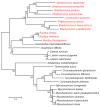A new twist on an old pathway--accessory Sec [corrected] systems
- PMID: 18544071
- PMCID: PMC2597500
- DOI: 10.1111/j.1365-2958.2008.06294.x
A new twist on an old pathway--accessory Sec [corrected] systems
Erratum in
- Mol Microbiol. 2008 Oct;70(1):271
Abstract
The export of proteins from their site of synthesis in the cytoplasm across the inner membrane is an important aspect of bacterial physiology. Because the location of extracytoplasmic proteins is ideal for host-pathogen interactions, protein export is also important to bacterial virulence. In bacteria, there are conserved protein export systems that are responsible for the majority of protein export: the general secretion (Sec) pathway and the twin-arginine translocation pathway. In some bacteria, there are also specialized export systems dedicated to exporting specific subsets of proteins. In this review, we discuss a specialized export system that exists in some Gram-positive bacteria and mycobacteria - the accessory Sec system. The common element to the accessory Sec system is an accessory SecA protein called SecA2. Here we present our current understanding of accessory Sec systems in Streptococcus gordonii, Streptococcus parasanguinis, Mycobacterium smegmatis, Mycobacterium tuberculosis and Listeria monocytogenes, making an effort to highlight apparent similarities and differences between the systems. We also review the data showing that accessory Sec systems can contribute to bacterial virulence.
Figures




Similar articles
-
Protein export by the mycobacterial SecA2 system is determined by the preprotein mature domain.J Bacteriol. 2013 Feb;195(4):672-81. doi: 10.1128/JB.02032-12. Epub 2012 Nov 30. J Bacteriol. 2013. PMID: 23204463 Free PMC article.
-
Canonical SecA associates with an accessory secretory protein complex involved in biogenesis of a streptococcal serine-rich repeat glycoprotein.J Bacteriol. 2011 Dec;193(23):6560-6. doi: 10.1128/JB.05668-11. Epub 2011 Sep 30. J Bacteriol. 2011. PMID: 21965576 Free PMC article.
-
The Accessory SecA2 System of Mycobacteria Requires ATP Binding and the Canonical SecA1.J Biol Chem. 2009 Apr 10;284(15):9927-36. doi: 10.1074/jbc.M900325200. Epub 2009 Feb 23. J Biol Chem. 2009. PMID: 19240020 Free PMC article.
-
The Two Distinct Types of SecA2-Dependent Export Systems.Microbiol Spectr. 2019 May;7(3):10.1128/microbiolspec.psib-0025-2018. doi: 10.1128/microbiolspec.PSIB-0025-2018. Microbiol Spectr. 2019. PMID: 31215505 Free PMC article. Review.
-
Protein export systems of Mycobacterium tuberculosis: novel targets for drug development?Future Microbiol. 2010 Oct;5(10):1581-97. doi: 10.2217/fmb.10.112. Future Microbiol. 2010. PMID: 21073315 Free PMC article. Review.
Cited by
-
Intra-plastid protein trafficking: how plant cells adapted prokaryotic mechanisms to the eukaryotic condition.Biochim Biophys Acta. 2013 Feb;1833(2):341-51. doi: 10.1016/j.bbamcr.2012.06.028. Epub 2012 Jun 28. Biochim Biophys Acta. 2013. PMID: 22750312 Free PMC article. Review.
-
Subcellular localization of extracytoplasmic proteins in monoderm bacteria: rational secretomics-based strategy for genomic and proteomic analyses.PLoS One. 2012;7(8):e42982. doi: 10.1371/journal.pone.0042982. Epub 2012 Aug 9. PLoS One. 2012. PMID: 22912771 Free PMC article.
-
Protein transport across and into cell membranes in bacteria and archaea.Cell Mol Life Sci. 2010 Jan;67(2):179-99. doi: 10.1007/s00018-009-0160-x. Epub 2009 Oct 10. Cell Mol Life Sci. 2010. PMID: 19823765 Free PMC article. Review.
-
Bacterial Secretion Systems: An Overview.Microbiol Spectr. 2016 Feb;4(1):10.1128/microbiolspec.VMBF-0012-2015. doi: 10.1128/microbiolspec.VMBF-0012-2015. Microbiol Spectr. 2016. PMID: 26999395 Free PMC article. Review.
-
Gram-Positive Uropathogens, Polymicrobial Urinary Tract Infection, and the Emerging Microbiota of the Urinary Tract.Microbiol Spectr. 2016 Apr;4(2):10.1128/microbiolspec.UTI-0012-2012. doi: 10.1128/microbiolspec.UTI-0012-2012. Microbiol Spectr. 2016. PMID: 27227294 Free PMC article. Review.
References
-
- Archambaud C, Nahori MA, Pizarro-Cerda J, Cossart P, Dussurget O. Control of Listeria superoxide dismutase by phosphorylation. J Biol Chem 2006 - PubMed
-
- Bensing BA, Sullam PM. An accessory sec locus of Streptococcus gordonii is required for export of the surface protein GspB and for normal levels of binding to human platelets. Mol Microbiol. 2002;44:1081–1094. - PubMed
-
- Bensing BA, Takamatsu D, Sullam PM. Determinants of the streptococcal surface glycoprotein GspB that facilitate export by the accessory Sec system. Mol Microbiol. 2005;58:1468–1481. - PubMed
Publication types
MeSH terms
Substances
Grants and funding
LinkOut - more resources
Full Text Sources
Other Literature Sources

